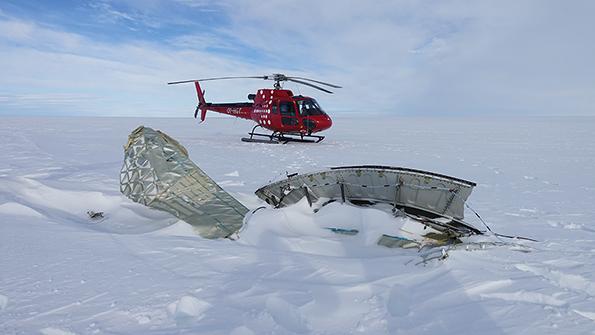
Conclusions from the persistent investigation of an Engine Alliance GP7200 engine failure found that maintenance actions played no role in the accident chain, but the probe could lead to new engine-inspection protocols as part of an effort to mitigate risks uncovered by investigators.
French accident investigation bureau BEA released its final report on Air France Flight 66 (AF66) nearly three years to the day after the accident took place on Sept. 30, 2017. The probe concluded that a crack started in a specific area, called a macro zone, introduced during forging of the fan hub. The crack formed 1,850 cycles into the part’s 15,000-cycle life and expanded over the next 1,650 due to dwell fatigue until the part failed. The failure left only a small part of the fan hub attached to the Airbus A380’s No. 4 engine, offering investigators a key early clue.
Macro zones, or micro-texture regions, are common in forged titanium parts. Unlike the rest of the part, these zones are anisotropic, meaning they do not have the same physical properties in all directions. This makes them ideal spots for cracks to start under certain conditions.
Macro zones cannot be detected via nondestructive inspections, but treatments during the forging process reduce their size and, in theory, their risk. Larger parts usually include larger macro zones.
Dwell fatigue, which caused several premature fan disk failures in the early 1970s, is well understood as a product of a material’s response to constant stress. However, up until AF66, there was no evidence dwell fatigue presented risks to parts like the GP7200 made from titanium alloy Ti-6-4, due to the material’s properties.
Because of this and factors linked to how GP7200 blades are maintained, investigators—working hand-in-hand with Engine Alliance joint-venture partners GE Aviation and Pratt & Whitney—assumed a maintenance issue was the most logical explanation for why the hub broke apart. But the BEA wanted to be sure, and the only way to confirm the theory was to inspect the failed parts.
AF66’s circumstances made the always-challenging task of evidence recovery especially daunting. The Airbus A380 was flying over Greenland at Flight Level 370, en route from Paris to Los Angeles, when the No. 4 engine failed. Debris, including pieces of the failed engine’s fan hub, were soon scattered over the snow-covered ground below. The crew diverted to Goose Bay, Canada, and landed without incident.
It took investigators three separate search phases over 21 months using myriad techniques, including an experimental radar technology that detected key parts buried beneath snow and ice, to find the parts they needed. In the interim, however, investigators focused on maintenance as the most likely explanation for what started the process that led to the hub fracturing.
Simulations by Engine Alliance showed that a certain amount of damage in a high-stress area on the hub could produce the type of failure the Air France engine experienced. GP7200 operators faced a series of visual and eddy-current inspection mandates targeting the most likely area of concern—the front surface of parts that could be damaged by tools or other maintenance actions.
The inspections found damage to more than 20 hubs, and early findings further supported the maintenance-damage theory.
“The size of the surface damage required for a crack to initiate and propagate to failure, in a number of cycles comparable to [the engine that failed] was of the same order of magnitude as certain damage observed during these post‑accident inspections,” the BEA’s final report notes.
Guided in part by the findings, Engine Alliance experts identified a particular maintenance procedure that—if done incorrectly—could lead to damage and, under the right circumstances, a fan hub failure. The manufacturer redesigned a key part, a blade lock ring, involved in the procedure.
Despite findings mapping possible failure scenarios, investigators needed evidence that linked maintenance actions to the Air France engine failure. In July 2019, they found the evidence they needed but were surprised at what it proved.
Examination of the hub fragment recovered showed evidence of a low-cycle fatigue crack that originated within the part. It was 5.6 in. behind the front hub face and 0.055 in. below the part’s surface. No maintenance-related damage was found, nor were there any manufacturing or material-quality anomalies.
“The fragment was analyzed and revealed that the failure, which originated in a macro zone in the subsurface of a blade slot bottom, occurred due to a cold dwell fatigue phenomenon,” the BEA report says. “At the time of the part design and engine certification, it was accepted by the scientific community, the industry and the certification authorities that Ti-6-4 was not sensitive to the cold dwell fatigue phenomenon.”
The BEA’s findings prompted it to recommend that the European Union Aviation Safety Agency (EASA) and the FAA review manufacturing of “rotor-grade critical parts” made out of Ti-6-4 and certain other titanium alloys so that risks presented by macro zones can be better understood.
“The tendency to increase the size of engine fans to reduce engine fuel consumption may lead engine designers to try and substantiate higher acceptable stress levels, to limit the weight of these engines,” the BEA says. “This may lead to an increase in the risk of a cold dwell fatigue incipient crack in a macro zone.”
In-service engines also need attention.
“EASA and the FAA will subsequently make sure, where appropriate, that an adapted in-service inspection program is implemented to detect possible incipient cracks which might lead to the failure of the part,” the BEA says.





